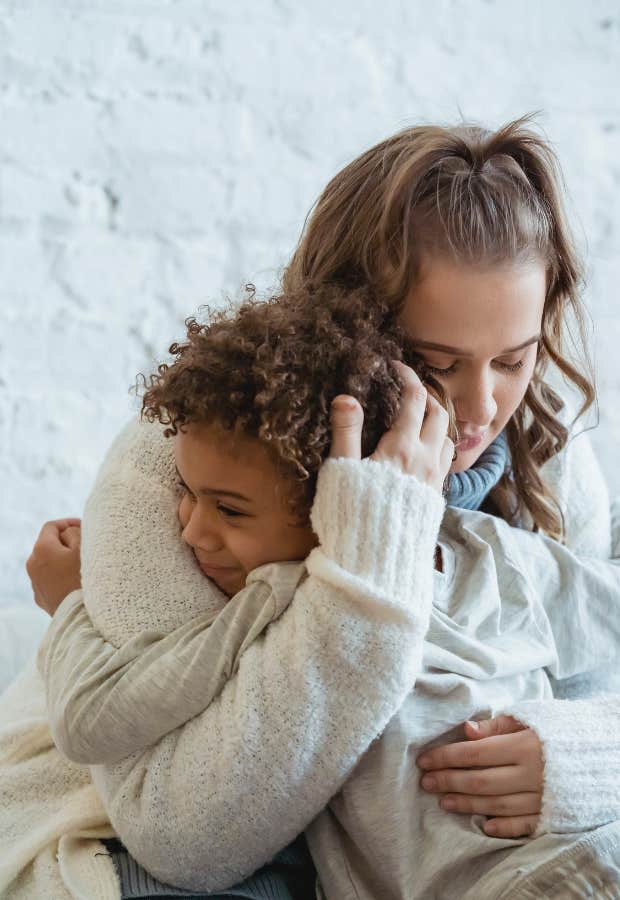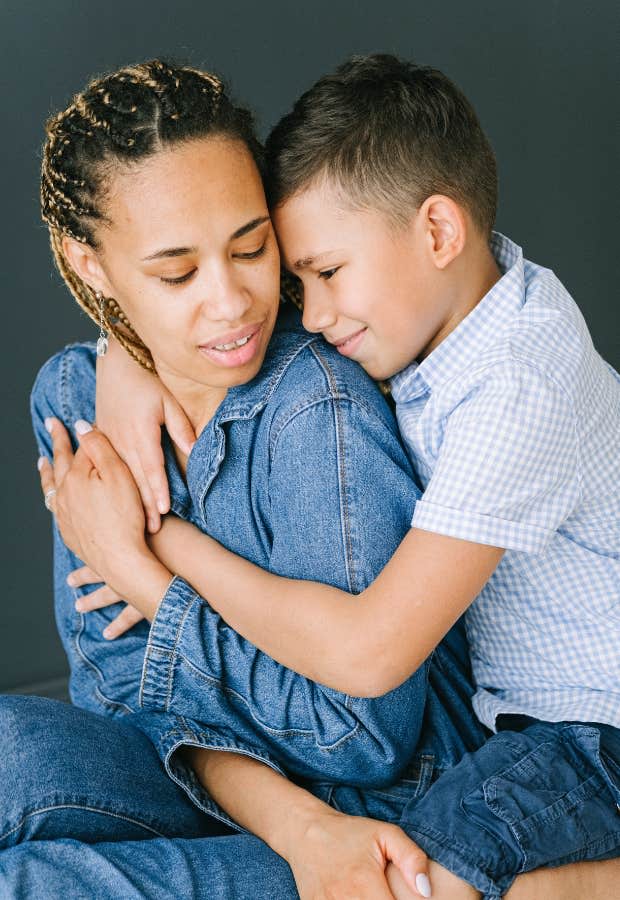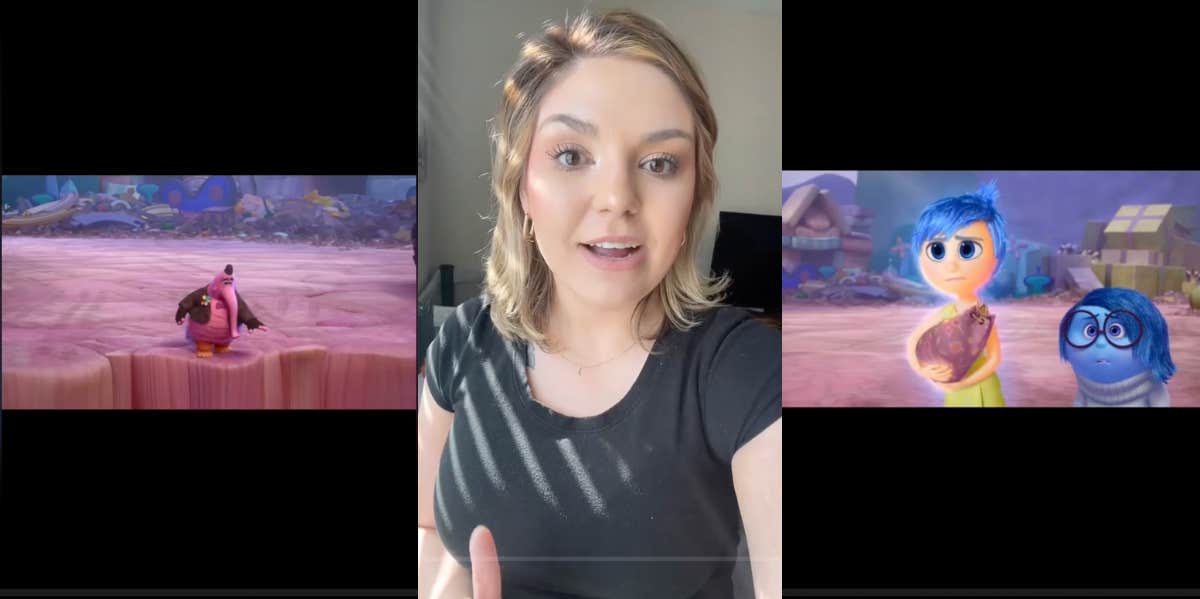Child Therapist Uses A Specific Scene From The Movie 'Inside Out' To Show Parents & Kids The Wrong Way To Respond When Someone's Sad
In her TikTok bio, Tracy Wilshusen shares the various roles she holds, describing herself as a “toddler mom, child therapist, and wife.” In a recent post, Wilshusen shared a technique she uses to help parents and kids shift the way they handle big emotions.
The child therapist shared a specific ‘Inside Out’ scene that she uses to show parents and kids the wrong way to respond when someone is sad.
She started her TikTok by introducing the movie clip, explaining that she uses it “with my kids and their parents constantly.” In the scene, Bing Bong, the elephant who’s Riley’s imaginary childhood friend, watches as the rockets he planned to take to the moon get bulldozed off a cliff. He experiences both a literal loss and the loss of a future opportunity that he’d been counting on.
Bing Bong sinks down to the ground, defeated. Joy, the pixie-like character who represents happiness, tries to comfort Bing Bong in the best ways she knows how. She tells him, “Hey, it’s gonna be okay. We can fix this.”
Joy tries to make Bing Bong laugh. She tries to redirect his attention. She clearly cares about Bing Bong and wants him to feel better, yet she doesn’t feel comfortable letting him experience a difficult emotion.
RELATED: 11 Signs You Were Raised By A Bad Mother Or Father (And It's Affecting You Now)
In contrast, Sadness, a little blue blob with consistent depression, sits down beside Bing Bong and voices the painful truth. She tells Bing Bong, “I’m sorry they took your rocket. They took something that you loved. It’s gone. Forever.”
Joy admonishes Sadness, telling her not to make Bing Bong feel worse by pointing out how sad it all is.
Yet the approach that Sadness takes provides space for Bing Bong to express how he feels, even though the emotions are hard.
Sadness listens as Bing Bong recounts his memories, allowing him to process the way he feels. It’s only after he moves through those hard emotions that he feels ready to move forward.
Wilshusen included her own text explanations throughout the clip, stating, “A lot of parents try to ‘fix’ or distract their kids when they have big feelings. It invalidates the child’s feelings and teaches them to label different emotions as good or bad.”

Photo: Keira Burton / Pexels
She advises parents to “Validate and allow the child to ‘sit with’ the emotion. Let them process the emotions instead of repressing them.”
She offered different techniques parents can do with their kids to help them navigate the stormy seas of having wide-ranging emotions.
She said, “Drawing, journaling, hugs, deep breathing, and talking to loved ones are great ways to process big feelings.”
Wilshusen ended her post by offering one last piece of guidance, stating, “Remember, there are no bad or good emotions, we must feel all the feelings.”
The ‘Inside Out’ clip illustrates the value of being allowed to feel our feelings, even when they’re hard.
The comments that Wilshusen received on her post showcased how tender parents feel, both as witnesses to their children’s pain and adults trying to understand their own range of emotions.
RELATED: Why Tom Cruise 'Chooses Not To See' His Daughter 11 Years After Their Last Sighting Together
One person said, “This made me cry, knowing I’m still trying to regulate my emotions and my kid’s emotions I’m still trying to understand."
Wilshusen replied by recognizing and validating that parent’s experience, saying, “That’s such a hard part of becoming a parent a lot of people don’t talk about.”
Another mom stated, “I honestly can’t even think sometimes when my child is crying. Then seeing these videos makes me cry, I’m just that broken.”
Wilshusen replied, “You’re not broken! It’s totally okay to become overwhelmed.”
That particular comment highlights a commonly held belief that runs through our society’s subconscious — that feeling hard feelings somehow means we are broken. Both Wilshusen’s post and her direct response to that mom are rooted in the belief that it’s entirely normal to feel emotions; what’s not normal is the way we’re expected to tamp those feelings down, as though ignoring them makes them disappear.
“Always give yourself permission to feel,” Wilshusen reiterated in the comments.

Photo: Ivan Samkov / Pexels
Some parents shared how they respond to their little one’s big feelings. One mom explained, “I say, ‘It’s okay to feel how you do. Do you want to talk about it?’”
Another mom said, “I say, ‘I hear you,’ and let the feelings flow through.” A different mom explained, “I always tell my daughter, ‘You’re safe, mommy’s here,’ and that it’s okay to be sad.”
As one parent noted, “It’s hard, but acknowledging and sitting in their emotions is so much more healing.”
Wilshusen posted a follow-up video in response to the question, “How can I best validate my toddler’s feelings while still working through the hard?”
In that TikTok, Wilshusen addressed the issue as both a child therapist and the mom of a toddler, speaking from a place of professional and personal experience.
She explained, “The first thing is, you want to start with the things you can say to them. So, I always tell my daughter, ‘Momma’s here, you’re safe,’ and I repeat that over and over again. Just letting them know that you’re here. If your toddler is at the age where they can label emotions, then if they say, ‘I’m sad,’ [you say] ‘I know you’re sad, it’s hard.’ Just kind of validating their emotions that way.”
Wilshusen offered a practical tactic to help young ones sit with their emotions, saying, “Something I love is creating a ‘calming corner’ for your toddler, so they have a space they can go to when they’re upset.”
She shared an example of the space she uses as a calming corner in her office. The walls were decorated with posters, guiding kids to help label their emotions and practice deep breathing. She also recommended making a basket of things to comfort a toddler when they’re upset, including a stuffed animal, a blanket, and some type of sensory tool.
It’s a completely natural response to want to fix the hard parts of life for the people we love, yet that response doesn’t allow for actual healing. We must do the difficult work of sitting in the muck of how we feel, recognizing that there’s no moral value to be placed on emotions. All emotions are valid, even the ones that feel awful. Allowing ourselves and our loved ones to fully feel is what creates space for healing.
RELATED: 12 Things A Childhood Trauma Therapist Is 'Begging Parents To Stop Doing'
Alexandra Blogier is a writer on YourTango's news and entertainment team. She covers parenting issues, pop culture analysis and all things to do with the entertainment industry.
This article originally appeared on YourTango


